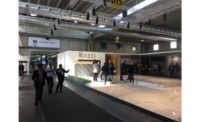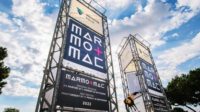CSTD: I understand that the “Event” sculpture was created prior to the One Dalton project and was on display at the Lyman Allen Art Museum in New London, CT. How did the design of the sculpture first come about?
DP: The concepts of interdependence, balance and contingency are fundamental to my sculpture. As a former athlete, I have always trusted things through my body, as well as with my mind. For most of my early life as a hockey player, one of my fortes was the open ice body check that could, in an orchestrated moment of collision, change the direction of the game. Even now as a sculptor, it is through my body in action at work and through exertion that I create sculpture in granite. The scale of the work and the labor in the quarry reflect this physicality and show evidence of my personal interaction with the stone in the creative process. The early balanced sculptures were typically composed of two elements -- each shaped organically with compatible weights; one self-supporting element sitting securely upon a flat base condition and a second element leaning into a mutual point of connection. Since 1992, with the making of each new sculpture, I have pushed the dynamic relationship between the two elements by experimenting with details, including less surface area at the point of connection, minimizing the ground connection, and increasing the lean and sense of precariousness. The elements of “Event” stand more vertical, autonomous, yet still connected, with a more open accessible and spatially inviting interior. “Event” is the latest sculpture of this ongoing series of signature works that are in collections around the world including:
- “Contingent” commissioned for the Chubu Museum and Cultural Center in Kurayoshi, Japan (Designed by the late great architect Cesar Pelli and the late landscape architect Diana Balmori.)
- “Nubian Blue” for the Aswan Sculpture Symposium commissioned by the Egyptian Ministry of Arts and Culture.
- “Perseverance” for the Lincoln Financial Sculpture Walk Collection, Riverfront Recapture, Hartford, CT.
- “Kiss,” first exhibited at Storm King Art Center and now permanently installed in a private collection in North Salem, NY.
- “Blue on White,” on temporary loan exhibition at Symposium Norge, Lundhs, Larvik, Norway.
CSTD: Did you have intentions for the sculpture to eventually find a permanent home, as it did at One Dalton?
DP: “Event” was originally installed within a designed landscape directly across from the front of the neoclassical granite clad Lyman Allyn Museum of Art. The sculpture was meant to be a monumental exclamatory point of arrival within a whole new entrance roadway winding through the landscape to the front of the museum. That new design never happened and so “Event” was left out in limbo with her back to the museum. In contrast, One Dalton is located in a dynamic urban context in the heart of Boston. This is now Boston’s tallest skyscraper rising 61 stories -- a sleek modern skyscraper reflecting the skyline. This triangular site is located in a complex configuration of streets adjacent to the Brutalist Christian Science Building. “Event” was specifically adapted enhanced realigned and re-sited to this permanent home to be experienced by residents entering and exiting the building, but also by pedestrians walking through the area and meeting the sculpture as a catalyst -- as Nature.
My intention is always to work with the existing context, but the idea is also to work with collaborators and clients who are uncompromising about realizing the project to the highest level. Through fruitful collaboration with Laura Solano of MVVA on the design of the ground, the addition of the third element and the site integration I was able to push the fundamental concepts of dynamic balance further and complete the sculpture for this specific place. Sculpture is typically one of the last details of these projects and logistics can get confusing in the mix but the owner Carpenter and Company, Inc. made sure that we had what we needed to make it all happen to the highest level, seamlessly on budget and on schedule. Barnhart Crane handled the sculpture expertly and worked within the tight confinement of the site next to a glass building façade. We had to deal with the complications of rigging the sculpture down into place inches away from a protruding metal and glass canopy over the entrance. Instead of viewing this situation as a liability we took advantage of it as another opportunity to connect the sculpture to the architecture making another contextual relationship. I ended up making a cut out of the top edge of the vertical stone element set close to the canopy so that the stone now “accepts” the protruding metal piece.
Jennifer: How did it come about to have Event be a part of the building’s entry landscape design?
Darrell: Carpenter and Company Inc. worked with art consultant Kate Chertavian Fine Art to commission an internationally acclaimed art collection at the property. Through an introduction from Michael Van Valkenburgh Associates (MVVA), I was invited to propose a site-specific sculpture. My original proposals were not quite right for this site, and frankly, I think I was forcing it. What felt very natural and I could envision very dynamic for this site was in fact a sculpture that I had already created. So when I discussed this with Laura, she agreed wholeheartedly, and Michael Van Valkenburgh supported the idea of integrating my 65-ton granite sculpture “Event” into One Dalton. Of course, it was critical that the late architect Harry Cobb agreed that the sculpture would be a good fit.
Mark Hirschbeck of MVVA worked diligently with me on the ground to supervise the landscape design, and so I include Mark’s description: “’Event’ is sited where pedestrians and vehicles overlap; it is experienced differently from every approach. Topography plays a subtle, but important role, in defining and differentiating its spatial envelope by elevating it 18 inches above the surrounding grade, which reinforces its monumentality. This soft mound was also just enough to mask the sculpture’s foundation and to increase soil volume for plants. The monumentality, bold forms, and surface textures of ‘Event’ called for a quiet and consistent treatment at its base. Plants offered a complementary, but unassuming solution. Monroe’s White Lily Turf (Liriope muscari ‘Monroe’s White’) forms an evergreen mat at the base of ‘Event’ and was selected for its strap-like, arching, dark leaves and tolerance of urban conditions. It grows to about 12 to 18 inches tall in tiered whorls with subtle white flowers in late summer.”
CSTD: What were your thoughts when MVVA proposed adding a third stone across the base of the sculpture?
DP: In our fruitful collaboration, we begin to read each other’s mind. My previous collaborative work with MVVA “Standing Stone,” (2017) opened up the relationships by integrating more elements into the arrangements. In order to integrate my sculpture, “Event” (2019) at One Dalton, we decided to introduce a third interloping element of Barre Grey granite; 16 feet long x 2 feet, 6 inches wide x 5 feet, 4 inches high weighing 12 tons. The low horizontal Barre Grey granite element frames the outer edge of the mound, hiding the base connections of the Stony Creek granite shielding the sculpture from the more public vehicular street side. There is limited surface area touching the ground at the base of the vertical Stony Creek granite element and a lightness -- pushing the dynamic of contingency and enlivening the sculpture. The spacing between all three elements creates curious interstitial spaces where we may measure ourselves in the figural voids. From the One Dalton Street view, the third element is just 6 inches high off the ground -- emerging in a slow gradual horizontal extension moving toward Clearway Street Extension, rising to a height of 5 feet, 4 inches. What I like about this horizontal movement is that it creates a direction that keeps the eye, mind and body moving toward the Christian Science Building and leading us toward openings of Clearway Street extension. This slow horizontal movement of the third horizontal element turning the corner keeps the parallax alive, as we have to walk to find out and experience the sculpture from different perspectives. From the view from the entrance/exit of the building -- the third stone is seen behind the balanced Stony Creek granite elements framing or “enclosing” the interdependent couple, and in effect blocking out the more complicated background of vehicular movement.
CSTD: What would you say was the most challenging and/or memorable aspect of the project?
DP: The most challenging aspect was the integration of a 65-ton sculpture into such a small site given the complexity underground and the challenge of designing a site specific footing for a balanced sculpture accounted for seismic conditions and wind loads. For the past 35 years, I have worked collaboratively with Silman to create innovative structural solutions that have celebrated the underlying sculptural concepts. Working in this fruitful collaboration with one of the great structural engineering firms, I am never limited in my thinking and always encouraged to pursue the thresholds of the fundamental concepts of interdependence and balance. For “Event” at One Dalton Boston, we poured underground concrete piers to rise up out of the ground and support each of the sculptural elements. These footings support the loads of the sculpture and stabilize the balance, and by being concealed 4 to 6 inches beneath ground level help to create a sense of rootedness to the sculpture rising out of the earth. That perception and experience of 25 to 35+ ton elements being “light footed” and the resultant “feeling” of the internalizing of structural forces is something I wanted here. It’s not simply the act of dropping a sculpture atop a plinth, but rather an interdependent balance composition in dynamic relationship with the specific architectural context where the concealed footing, the landscaped mound, the plantings and the sculptural granite are all equal elements.
CSTD: Is there anything else that you would like to share?
DP: My grandfather was born in Cambridge, MA, more than 125 years ago, and so this is coming home for me. I return to at least one root of my family tree. In a sense, it is my calling to now be contributing “Event” to Boston, a sculpture that responds to a specific environment, that engages the community, that enriches the urban environment, that will endure forever and that adds to the authentic cultural identity of Boston. I am excited by the new focus on public art in the city, and look forward to the opportunity of creating more sculpture projects for Boston.










